Updated: 13-Feb-2020
Romanian Mr. Henri Coanda built several aircraft, including a biplane with a Clerget in-line, 4-cylinder engine that, instead of driving a propeller, was driving a compressor that aspired and blew backwards, considered a multiple tube propeller.

"Coanda"
-It can be considered as a new concept of propulsion plant.
-During the 1910 trials, it inadvertently went into the air and crashed. Later Coanda used propellers. This system has been proposed here as a complete power train.
- In 1911, there was another novelty of a twin-engine propulsion group consisting of two Gnomes located on each side of the fuselage driving a single propeller at the front of the aircraft.

"Coanda twin engine"
-We located a photograph of the compressor used on Coanda's first aircraft.
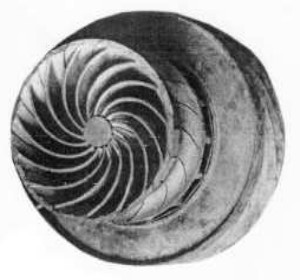
"Complete Coanda compressor"
-As we already know the compressor was powered by a Clerget four-cylinder. The propulsion group had speed multiplier gear, between engine and compressor.

"System diagram"
-A two-stage gear system - dark in the drawing - was increasing the speed rate of the compressor:
-From the engine comes out a shaft with a larger gear that drives a smaller gear. In turn this smaller one is solidary to another larger gear and finally this larger one drives a smaller one, multiplying the speed of rotation.
-As we see the compressor is centrifugal, but acts like a propeller.
From Appendix A7/6: We can see Coanda's machine, which is hardly mentioned in the main text, in more detail in the following illustration.
-In terms of that time it is said that it had a "suction turbine".
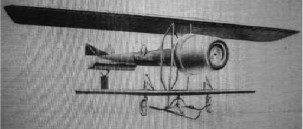
"Coanda's airplane"
-Described this way, it is not a first jet aircraft as it has been said several times, but it has a special propeller that aspires by the shape and profile of the rotor vanes.
-We have found another application of this principle by Coanda himself. He modified a part of the hull of one of his airplanes as a sleigh.

"Coanda's sleigh"
-If in the original aircraft they used a four-cylinder Clerget, it seems that in this sleigh they used probably another Clerget as there appear heads of a vertical cylinder engine.
-In a front view of the same appliance, we note that the air intake is protected by a grid to protect the engine and the ingested object in event of a collision.
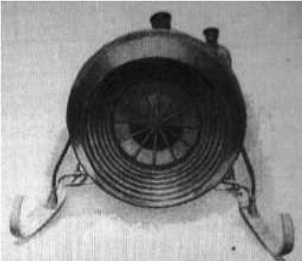
"Front view of Cloanda's sleigh"
-It is also reported that the sleigh was made for Grand Duke Cyril of Russia.
-Finally we found an illustration of one of Coanda's intubed-propeller engine patents.

"Coanda's patent nr 4446695"
From Appendix 9: From an information by LS Cozma, who has investigated Coanda's work (see main text), has located patents of this unique Romanian pioneer Coanda.
-This is not an engine but a propulsion system that, like his better known first project, uses the compressed air from the front compressor (today we would say Fan) to send it to the main planes as well as the empennage.
-This air leaves while rubbing the surfaces making them more effective at low speeds.
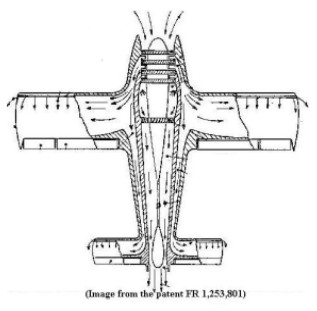
"Coanda's patent drawing"
-This control, without needing the aircraft to reach normal speeds, perhaps allows the aircraft to also be STOL.
-Perhaps it is only a later project based on Coanda's idea and therefore they used his name.
From Appendix 10: New images of the Coanda twin engine for a single propeller. The two engines are transverse to the airplane's flying direction. It has a mechanical adaptation from Coanda with two Gnome Gammas.

"Airplane and project"

"Coanda system exhibition"
-The double-engine idea designed by Coanda is clearly seen in the following drawings and photographs.
-Two Gnome Rhone engines coupled by a transmission, spinning transversely to the aircraft's flying-direction is an idea that Salmson (see) would use later as well.
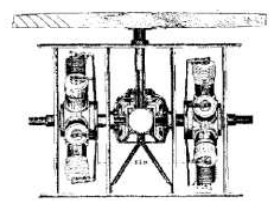
"Theoric design for the described assembly"

"Realization of Coanda's assembly"
-A strange experiment of Coanda towards the year 1922. Titled "Backward movement and propulsion wing".
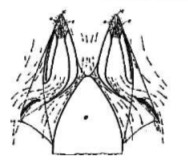
“Coanda's experiment design” (PiP-Flu)
-We are looking for more information. Possibly it is an extract from a patent at the DRP.
-Henri Coanda developed his work in France. With keen ingenuity he also developed his "Coanda Effect" propulsion theory.
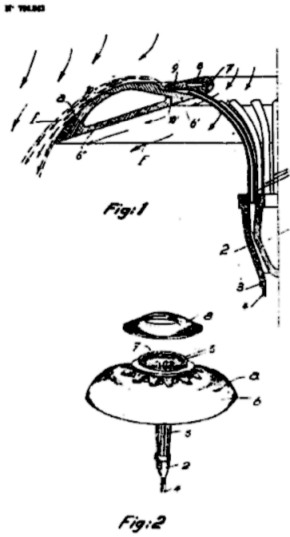
"Patent based on the Coanda Effect"
-The Coanda Effect is the tendency to stick to the wall when a fluid flows close to it.
-It can be used to drag other fluids and increase the thrust. For the author of this work it may be the same principle of the new "Spike" engines that without having the nozzle closed, produce the same effect.

"Another development of the same principle"
-When the last drops that leave the teapot flow along the conduit, it can be considered as a "Coanda effect". Such adhesion to the teapot can be a simple example. The drops do not fall vertically, they go down along the outer teapot and stain the tablecloth.
Engines of COANDA
Model: Combined propulsion with Clerget engine
Model: Twin Gnome

"Coanda twin-engine"


